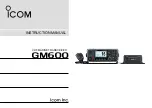
Frequency Synthesized UHF Belt-Pack Transmitter
Rio Rancho, NM
No Pre-Emphasis/De-Emphasis
The signal to noise ratio of the hybrid system is high
enough to preclude the need for conventional pre-em-
phasis (HF boost) in the transmitter and de-emphasis
(HF roll off) in the receiver. Pre-emphasis and de-em-
phasis in an FM radio system usually provides about
a 10 dB improvement in the signal to noise ratio of the
system, but the high frequency boost in the transmitter
must be removed in a purely complementary manner or
else the frequency response of the original audio signal
will be altered.
Pre-emphasis can also cause distortion in the receiver.
As this signal is passed through the IF filters in the
receiver, distortion can be produced, most noticeably at
full modulation. De-emphasis cannot be applied until
the signal is converted into audio, so there is no way
around this problem short of eliminating pre-empha-
sis altogether. Neither of these problems occur in the
hybrid system design.
Pilot Tone Squelch
The system uses one of 256 different ultrasonic tones
between 25 and 32 kHz, that modulate the carrier to
operate the receiver squelch. The pilot tone frequency
is chosen according to which of the 256 channels has
been selected by the frequency switch setting. The pur-
pose of the pilot tone squelch system is that the receiv-
er will remain muted until it receives the pilot tone from
the matching transmitter, even if a strong RF signal is
present on the carrier frequency of the system. The
UM400a extends this concept even further by ensuring
that all transmitters in a system have different pilot tone
frequencies so that even spurious RF from the wrong
transmitters can’t open the receiver squelch.
Input Limiter
The transmitters employ a digitally-controlled analog
audio limiter just before the analog-to-digital converter.
The limiter has a range of more than 30 dB for excellent
overload protection. A dual release envelope makes
the limiter acoustically transparent while maintaining
low distortion. It can be thought of as two limiters in
series, connected as a fast attack and release limiter
followed by a slow attack and release limiter. The limiter
recovers quickly from brief transients, so that its action
is hidden from the listener, but recovers slowly from
sustained high levels, to both keep audio distortion low
and preserve short term dynamic changes.
Generally speaking, some limiting is desirable in normal
operation to improve the signal to noise ratio of the
system. The limiting action is not audible and does not
create distortion. A highly trained ear would hear only
the compression of the peaks in the audio signal, which
is desirable with most recorders and many sound rein-
forcement systems.
Wide-Band Deviation
± 75 kHz deviation improves the capture ratio, signal to
noise ratio and AM rejection of a wireless system dra-
matically, compared to the more commonly used ±15
kHz deviation.
Frequency Selection
The transmitter section uses a synthesized, frequency
selectable main oscillator. The frequency is extremely
stable over a wide temperature range and over time.
Two rotary switches, located on the side panel of the
unit, provide 256 frequencies in 100 kHz steps over a
25.5 MHz range. This alleviates carrier interference
problems in mobile or traveling applications.
Antenna
The antenna on the UM400a consists of a rugged 1/4
wavelength stranded and galvanized steel cable, de-
tachable via an SMA connector. The impedance of this
antenna port is 50 Ohms.






































